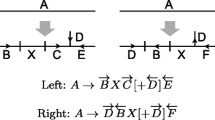Abstract
This paper introduces a new method to solve the irregular-shape, full-rotation nesting problem by a genetic algorithm. Layout patterns are evolved in hierarchical subgroups to facilitate the search for an optimal solution in such a complex solution space. The genotype used in the genetic algorithm contains both the sequence and rotation for each shape, requiring new genetic operators to manipulate a multi-type genetic representation. A lower-left placement heuristic coupled with matrix encoding of the shapes and plate prevents overlap and constrains the solution space to valid solutions. This new method is able to efficiently search the solution space for large problems involving complex shapes with 360 degrees of freedom. The algorithm generates better solutions than previously published evolutionary methods.
Similar content being viewed by others
References
Anand, S., Balachandar, T. and Sharma, R. (1999) An integrated machine vision based system for solving the non-convex cutting stock problem using genetic algorithms. Journal of Manufacturing Systems, 18, 396–415.
Bahrami, A. and Dagli, C. H. (1994) Hybrid intelligent packing system (HIPS) through integration of artificial neural networks. Artificial Intelligence and Mathematical Programming, 4, 321–336.
Bakirtzis, A., Kazarlis, S. and Petridis, V. (1998) Varying fitness functions in genetic algorithm constrained optimization: The cutting stock and unit commitment problems. IEEE Transactions on Systems, Man, and Cybernetics, 28, 629–639.
Beasley, J. E. (2000) A population heuristic for constrained two-dimensional nonguillotine cutting. Working paper available from the author at The Management School, Imperial College, London SW7 2AZ, England.
Cheng, C. H., Cheng, T. C. E. and Feiring, B. R. (1994) The cutting stock problem a survey. International Journal of Production Economics, 36, 291–305.
Dagli, C. H. and Poshyanonda, P. (1997) New approaches to nesting rectangular patterns. Journal of Intelligent Manufacturing, 8, 177–190.
Dagli, C. H. and Tatoglu, M. Y. (1987) An approach to two-dimensional cutting stock problems. International Journal of Production Research, 25, 175–190.
Dighe, R. and Jakiela, M. (1995) Solving pattern nesting problems with genetic algorithms: Employing task decomposition and contact detection, in Evolutionary Computation, MIT Press, Cambridge, MA.
Dowsland, K. A. and Dowsland, W. B. (1995) Solution approaches to irregular nesting problems. Statistics and Operational Research Group, European Business Management School, University College of Swansea, UK. Invited review in European Journal of Operational Research, 84, 506–521.
Flasse, S. P. and Renders, J. (1996) Hybrid methods using genetic algorithms for global optimization. IEEE Transactions on Systems, Man and Cybernetics–Part B: Cybernetics, 26.
Goldberg, D. E. (1989) Genetic Algorithms in Search, Optimization, and Machine Learning, Addison-Wesley, Reading, Massachusetts.
Hopper, E. and Turton, B. C. H. (2000) An empirical investigation of meta-heuristic and heuristic algorithms for a 2D packing problem. European Journal of Operational Research, 128, 34–57.
Ikonen, I. T., Biles, W. E., Kumar, A., Ragade, R. K. and Wissel, J. C. (1997) A genetic algorithm for packing three-dimensional non-convex objects having cavities and holes. Proceedings of the Seventh International Conference on Genetic Algorithms, pp. 19–23.
Ismail, H. S. and Hon, K. K. B. (1992) New approaches for the nesting of two-dimensional shapes for press tool design. International Journal of Production Research, 30, 825–873.
Kröger, Schwenderling and Vornberger (1993) Parallel genetic packing on transputers, in Parallel Genetic Algorithms Theory and Applications, Joachim S. (ed), IOS Press.
Li, Z. and Milenkovic, V. (1995) Compaction and separation algorithms for non-convex polygons and their applications. European Journal of Operation Research, 84, 539–561.
Liang, K. H., Yao, X., Newton, C. and Hoffman, D. (2002) A new evolutionary approach to cutting stock problems with and without contiguity. Computers & Operations Research, 29(12), 1641–1659.
Poshyanonda, P. and Dagli, C. H. (1993) Genetic neuro-nester for irregular patterns, in Intelligent Engineering Systems Through Artificial Neural Networks, Vol. 3, Dagli, C. H., Burke, L. I., Fernandez, B. R. and Ghosh, J. (eds), ASME Press, New York, p. 825.
Poshyanonda, P. (1994) Genetic neuro-nester. Ph.D. dissertation, Engineering Management Department, University of Missouri-Rolla.
Qu, W. and Sanders, J. L. (1987) A nesting algorithm for irregular parts and factors affecting trim losses. International Journal of Production Research, 25, 381–397.
Ratanapan, K. (1997) An object-based evolutionary algorithm for nesting problems. Ph.D. dissertation, Engineering Management Department, University of Missouri-Rolla.
Ratanapan, K. and Dagli, C. H. (1998) An object-based evolutionary algorithm: The nesting solution. Proceedings of 1998 IEEE World Congress on Computational Intelligence, pp. 581–586.
Author information
Authors and Affiliations
Rights and permissions
About this article
Cite this article
Fischer, A.D., Dagli, C.H. Employing subgroup evolution for irregular-shape nesting. Journal of Intelligent Manufacturing 15, 187–199 (2004). https://doi.org/10.1023/B:JIMS.0000018032.38317.f3
Issue Date:
DOI: https://doi.org/10.1023/B:JIMS.0000018032.38317.f3




